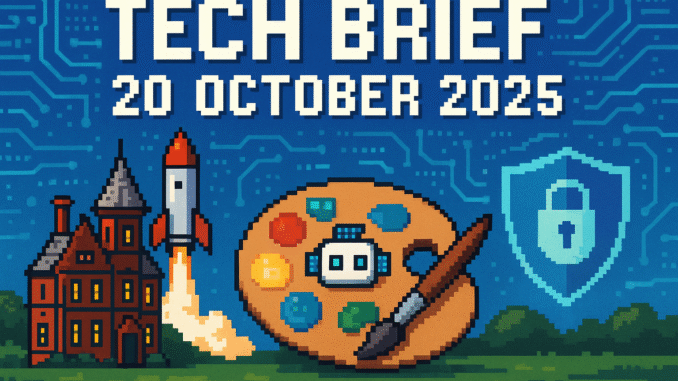
Tech Brief 20 October 2025 lands with a focus on quiet British engineering, AI’s creative controversies, and the human side of cyber defence. Some days are about big launches and spectacle, but today’s round-up looks at the quieter places where real change happens. Missed yesterday’s Tech Brief? Catch up here before diving in.
Surrey Lab’s Victorian Mansion Sends Tech to Mars
“Six decades on, and they’re still building rocket science in a Victorian mansion. Of course they are.” That was the reaction at this week’s editorial meeting after Mullard Space Science Laboratory, a fixture since 1966, confirmed new British-built hardware is heading to Mars. Tucked away in the Surrey Hills, this former country house has a habit of quietly making headlines.
The lab started with Mullard Ltd and has stayed a British tech stronghold for aerospace, even as much of the country lumps “space” in with memories of Blue Peter and BBC Micro robot competitions. Today, their innovations are heading for Mars, not just orbit. There’s something about British engineering doing the improbable from a converted stately home that never gets old.
What’s the upshot? We’re seeing the same pattern as in the Sinclair days. Unfussy, underhyped homegrown ingenuity is quietly reshaping the narrative, this time across millions of miles.
Vermillio Reveals How AI Art Tools Use Copyrighted Images
How much of your favourite pop culture artwork ends up in the datasets behind Big AI? Vermillio, a new platform, is trying to answer that. It reveals stark numbers about how AI tools are hoovering up copyrighted art.
Ask these algorithms for Doctor Who’s TARDIS and you won’t just get a blue box. You’ll see Google and OpenAI reproducing details straight from real designs, Disney’s Elsa included. Vermillio claims to show exactly which pre-existing images go into each AI rendering.
It’s hard not to spot parallels with the 90s, when music sampling wars spilled into courtrooms and fanzine columns. Except this time, every digital brushstroke is up for debate. Creatives and copyright lawyers are both watching closely. In a callback to those old remix battles, today’s artists and hobbyists are left asking: What’s fair use in a world where training data never forgets?
SolarWinds Cyberattack: The Hidden Human Toll
Tim Brown, the security chief who faced the SolarWinds breach, lost 25 pounds in just 20 days during the crisis. No stolen cars or dramatic escapes, just relentless waves of stress as Russian-backed hackers dug deep into US government infrastructure.
Brown’s story strips away the glamour of classic Hollywood hacking. This is life in a modern war room, where stress triggers literal heart attacks, not dramatic explosions. SolarWinds became the warning nobody asked for, leaving worn-out staff and a changed industry mindset.
What matters most to readers here is the human fallout. The hacker fantasy of the 80s is gone, replaced with exhausting vigilance and long hours. Today’s cybersecurity challenges need more than clever code. They need real people willing to bear the brunt. As explored above, quiet heroes rarely get the credit.
AI Deepfakes and the Blurring of Posthumous Rights
Would you like to see Karl Marx at a supermarket self-checkout, or Princess Diana DJing at a London club? OpenAI’s “Sora” can make that happen, at least on video. The debate is less about technical prowess and more about ethics. Legal minds are raising the alarm as Sora produces hyper-realistic, sometimes uncomfortably plausible, deepfakes of famous figures long gone.
There’s little historical precedent for this level of digital resurrection. Earlier panics over Photoshop hoaxes or retouched press photos seem quaint next to seeing Martin Luther King Jr. bantering on internet forums or Henry VIII mugging for modernity. The company walks a legal tightrope, possibly searching for where the world will draw the line.
Nobody knows if digital immortality is a blessing or something to dread. The next court case could set precedents for decades, or never catch up at all. Here, it’s hard to say which is scarier.
From the Wayback Machine
On This Day: 1994 – WhiteHouse.gov launched, putting the White House online for the first time. The original site ran on Sun Microsystems quad-processor servers, built by a small team that included Jock Gill, Eric Schmidt, and Sprint engineers. Content ranged from news and executive orders to Socks the cat photos.
At the time, fewer than 10,000 websites existed, and most households still ran Windows 3.1 with a 9.6kbps modem. Government websites were so novel that every submission to the President’s web form got press attention. The site’s success nudged other agencies to put information online, lifting the curtain on a new era of transparency.
Today’s Big Question
Are we prepared for the next turning point or are we still just patching the same old problems? Tech Brief 20 October 2025 suggests our tools grow more complex, but folly is still very human. If last year’s alerts taught us anything, it’s to keep asking which stories deserve a second look.
Still spinning up CP/M on the Amstrad, still not pretending digital dust smells nice. More stories soon. Stay curious, and always save your work, just in case.
Missed yesterday’s Tech Brief? Catch up here

Leave a Reply